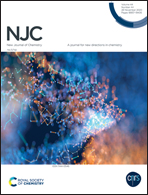A molecular electron density theory (MEDT) study of the role of halogens (X2 = F2, Cl2, Br2 and I2) on the aza-Michael-addition reactions†
Abstract
Using the Molecular Electron Density Theory (MEDT), a set of uncatalyzed and X2 molecule-catalyzed (X2 = F2, Cl2, Br2, or I2) aza Michael addition reactions (aza-MARs) between pyrrolidine (PYR) and methyl acrylate (MA) have been studied in the gas phase and in dichloromethane (DCM) medium from the kinetics and molecular mechanism aspects. Analysis of the conceptual DFT reactivity indices indicates that the coordination of the X2 molecules to the oxygen of the MA's carbonyl group increases both the softness and the electrophilic character of MA, thus explaining the catalytic role of the X2 molecules. The nucleophilic attack of the nitrogen of PYR on the MA's β conjugated carbon is the rate-determining step and an endothermic/endergonic process while the two consecutive steps, a proton shift and a tautomerization reaction, are exothermic/exergonic. The rate constant increases going from F2 to I2 in both phases with I2 enhancing the rate constant of aza-MARs 196 times with respect to the uncatalyzed reaction in the liquid (DCM) phase at room temperature, in good agreement with the experimentally determined values. Both ELF and AIM topological analysis reveal that the increase of both softness and the electrophilic character of the complexes MA-X2 is responsible for the acceleration found in these aza-MARs. The present MEDT study provides a rationalization of the catalytic role of the halogen X2 molecules which act as Lewis acid catalysts.



 Please wait while we load your content...
Please wait while we load your content...